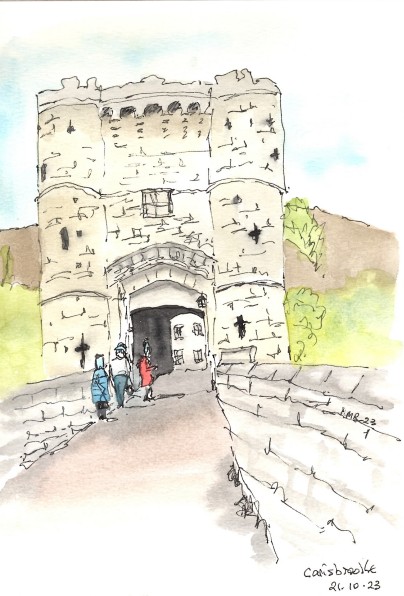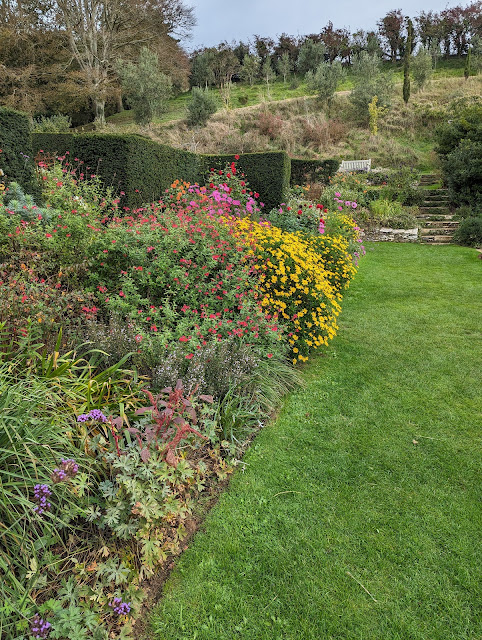The mental and physical health benefits of gardening are well-documented. The 12th of October 2023 was a fairly typical day at home.
 |
| Figure 1: Heart Rate Timeline for 12/10/23 |
Arising about 8 am (⦁) after 7 -8 hours of sleep, time for a leisurely breakfast before a request to move a heavy object upstairs (second ⦁), and an increase in heart rate! A period of general household chores, tea breaks, and shredding garden waste followed (first white period). Having fully warmed up, time for some strenuous work digging over the potato plot (second white period), then lunch (blue period) before finishing off the day's gardening with a bout of compost sieving (third white period). Mid-afternoon tea-break (⦁) before retiring indoors just before 6 pm (⦁).
Our granddaughter had helped to find most of the potatoes when she visited in early September. Mary and most of the children and grandchildren enjoy digging up potatoes - I suppose it is akin to finding treasure. Of course, they are not interested in the hard work that goes into preparing the crop. With the grandchildren, I make a 'game' of it by getting the children to weigh the crop and find the biggest (381 g) and smallest (1 g) potatoes. Fortunately, I don't have to go to such efforts for Mary!!
I have to congratulate our granddaughter on finding over 90% of the potatoes. As Photo 1 shows, she only missed a few that were recovered when I dug over the plot. Unfortunately, I found a larger specimen (429 g) so I will have to pick my moment when I tell her the bad news.
Photo 1 shows the plot after (i) getting rid of the cat poo, (ii) weeding, (iii) digging over and removing the potatoes missed on the first digging, and (iv) adding 100 L sieved compost.
 |
| Photo 1: Last Season's Potato and Sweetcorn Plot (Dug & Composted) |
After raking level ...
 |
| Photo 2: Last Season's Potato Plot - Dug, Enriched with Compost, and Raked Level |
... the plot was covered with black plastic to prevent the cats from using it as their toilet ...
 |
| Photo 3: Last Year's Potato/Sweetcorn Plot Put to Bed for the Winter |
In order to compare the health benefits of gardening with an alternative form of lifestyle, I looked for a non-gardening day with a similar level of activity; i.e. approximately the same number of steps. Fortunately, I only had to wait a few days for a comparative study. My day in the garden on 12th of October had a step count of 10,493.
On the 15th of October, we travelled to Rhayader for a short holiday. Last-minute jobs and packing up the car (first yellow period), driving to Rhayader (green period), two-hour walk in Gilfach Nature Reserve (red period), unpacking and settling into the accommodation (second yellow period) and evening concert (blue period). The step count for the 15th of October was 10443, just 50 steps short of the total for the 12th of October. Figure 2 shows the timeline for heart rate on 15th of October and for comparison with Figure 1.
 |
| Figure 2: Heart Rate Timeline (15/10/23) |
Average, maximum, and minimum heart rates for both days (12/10/23 and 15/10/23) were similar (
Table 1)
Table 1: Comparison of Heart Rates on Both Days
Heart Rate | Gardening (12/10/23) | Walking/General (15/10/23) |
Daily Average | 78 | 74 |
Daily Maximum | 135 | 128 |
Daily Minimum | 45 | 48 |
However, the intensity levels were different (Table 2) with much longer (3x) periods of aerobic/anaerobic activity on the gardening day (12/10/23).
Table 2: Relative Exercise Intensities (hours & minutes) for Both Days
Exercise-Type | Gardening (12/10/23) | Walking/General (15/10/23) |
Relaxed | 8h 33m | 8h 35m |
Light | 1h 33m | 1h 57m |
Intensive | 1hr 43m | 2h 1m |
Aerobic | 1h 12m | 27m |
Anaerobic | 27m | 7m |
Note that both days had levels of intensive exercise above the
daily recommended periods for someone of my age. The gardening day just had higher and included extra strengthening exercises (digging).
























































